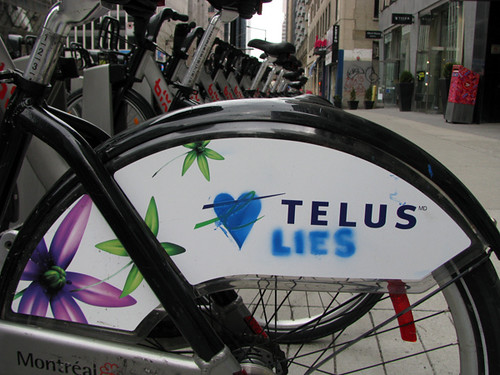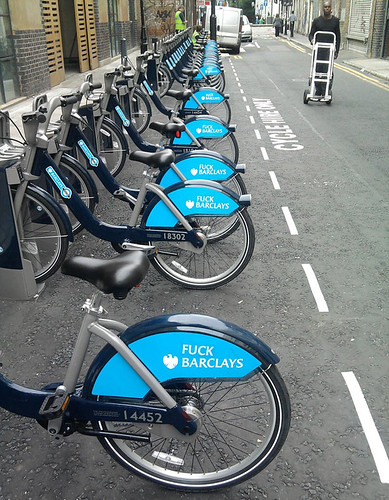Ground up (guerrilla) art #1: Artung ad attack, Montreal
 In Montreal, public space activists and artists executed an "art attack" on advertising kiosks in the public space, replacing the ads with images. The project, called Artung, is in part a response to advertising companies suing one of the city's borough governments, Plateau-Mont Royal, for banning the ad kiosks (45 in all) from their streets. (FWIW, this borough has the most number of members in the Bixi system there, and the most progressive local government political party, Projet Montreal, has the majority of seats and control of the borough government.)
In Montreal, public space activists and artists executed an "art attack" on advertising kiosks in the public space, replacing the ads with images. The project, called Artung, is in part a response to advertising companies suing one of the city's borough governments, Plateau-Mont Royal, for banning the ad kiosks (45 in all) from their streets. (FWIW, this borough has the most number of members in the Bixi system there, and the most progressive local government political party, Projet Montreal, has the majority of seats and control of the borough government.)From "ARTUNG! TURNS 200 MONTREAL ADS INTO WORKS OF ART" of the This is not an ad collective:
100 ad pillars and billboards across Montreal, owned by Pattison, CBS Outdoor and Astral Media were replaced today with community artwork. Artwork was created by 200 Canadian and International artists and installed by fifty public space activists operating under the name Artung!.
“Today, we transformed Montreal's outdoor ads into public works of art to send a message to advertising giants: to stop threatening residents of the Plateau with an unnecessary legal battle and immediately remove their visual pollution from the whole of Montreal’s cityscape,” said Vanessa Moraless, an Artung! campaigner.
Artung!'s action comes in response to threats made by Montreal's advertising giants to take the democratically elected Plateau Mont-Royal council to court for a November 2010 decision to ban 45 billboards in the borough. Jeannot Lefebvre, the industry spokesperson, argues the ban goes against the advertising companies’ right to freedom of expression and they'll legally pursue it until it is reversed.
According to Projet Montreal, each billboard only generates $1,000 in taxes for the city, an insignificant amount of revenue compared to profits made by these multi-national outdoor advertisers. Artung! supports the borough's decision to take action against billboards and the 78% of residents of the Plateau who favoured the ban.
Erkin reminds us that Montreal activists, unnamed, also challenged Montreal Bixi's inclusion of sponsorship identification (advertising) on the bikes (and docks) upon this season's reintroduction of the city's bike sharing system. See "Bixi: from source of pride to target of vandals" from the Montreal Gazette and "Bixi ad backlash" from Spacing Montreal--the latter has a series of photographs of various graffiti attacks on the sponsorship identifications, illustrating a wide variety of messages and ideas that as the author of the piece says "have provided a new, mobile space for Montrealers to spread messages and/or express their creativity."

Bixi sponsorship and vandalism, Montreal. Image from Spacing Montreal.
I'm of two minds about this. I understand why people are upset with "commodification of the public space" and the constant intrusion and escalation of the presence of advertising in more and more spaces in our lives.
At the same time, part of my business is trying to sell bicycle sharing systems, and that involves, often, the sales of sponsorships and advertising (in fact, I want a map-advertising kiosk with two slots for advertising, not one, to be able to generate more revenue because the systems cost a lot of money to operate). E.g., while we didn't win the bid for the Chattanooga system, we lined up a commitment from a major banking corporation operating in the Southeastern U.S. to sponsor the system... of course, after we saw the first foray against ad sponsorship blocks on bikeshare bikes in London, we've had to add enhanced "graffiti" response plans to our operating programs...

Labels: commodification and exchange, commodification of the public space, protest and advocacy, public art, public space management



0 Comments:
Post a Comment
<< Home